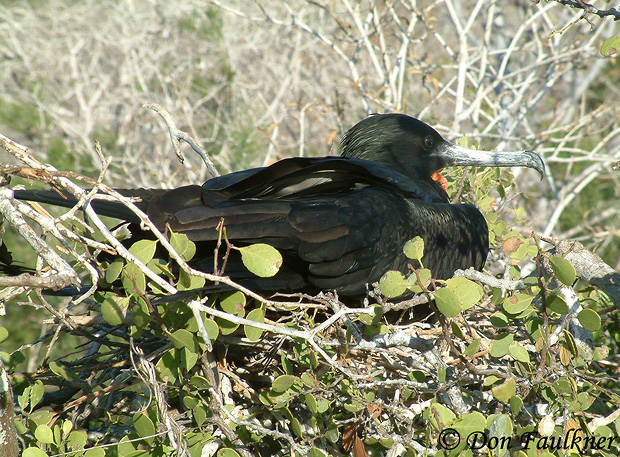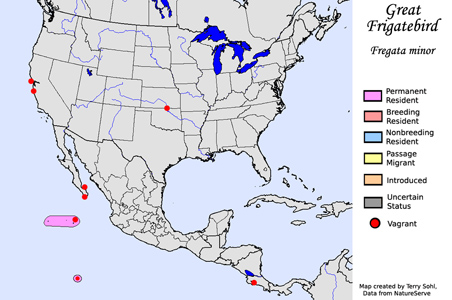| Length: 34 - 40 inches | Wingspan: 80 - 90 inches | Seasonality: Non-resident in South Dakota |
| ID Keys: Black and glossy overall, long forked tail, long bill with pronounced hook, reddish legs, males red sac on chin, females white on chest | ||
 The
Great Frigatebird is a large seabird of the tropical oceans, where they are
primarily found in the Pacific and Indian ocean basins. They are only rare
vagrants near the continental United States, with a handful of records off
the California coast, and one very lost bird found in Oklahoma. They
do have breeding colonies on the Hawaiian Islands, however, and breeding
colonies off the Pacific coast of Mexico. The birds are glossy black
overall, but males are smaller than females, and have an impressive red chin
sac they inflate during breeding. They are sometimes called "Iwa" in
the Hawaiian Island chain.
The
Great Frigatebird is a large seabird of the tropical oceans, where they are
primarily found in the Pacific and Indian ocean basins. They are only rare
vagrants near the continental United States, with a handful of records off
the California coast, and one very lost bird found in Oklahoma. They
do have breeding colonies on the Hawaiian Islands, however, and breeding
colonies off the Pacific coast of Mexico. The birds are glossy black
overall, but males are smaller than females, and have an impressive red chin
sac they inflate during breeding. They are sometimes called "Iwa" in
the Hawaiian Island chain.
Habitat: Found on a number of breeding colonies in the tropical, warm waters of the Pacific and Indian oceans, with a very restricted breeding range of a couple of islands off the coast of Brazil in the Atlantic ocean. There, they nest in bushes or mangroves, or more rarely, on the ground.
Diet: Feeds mostly on fish and squid, but also is known for taking chicks of other nesting birds, and will also occasionally take other marine creatures.
Behavior: Most often feeds by flying above the water's surface and when prey is spotted, dropping down to grab it in flight. They will also occasionally harass other seabirds that have caught prey in attempts to force them to drop it. In some areas and in some seasons, preys heavily on chicks in nesting colonies of other seabirds.
Nesting: A platform nest is built of sticks and other vegetation and placed in shrubs or in a mangrove. The female lays a single egg, and both the female and male will help to incubate it. Both parents tend to the young after hatching. Nesting for a female occurs every other year, as the fledgling typically stays with the parent for up to a year and a half after hatching. Pair bonds are not usually maintained for the long term, and males may mate with different females each year.
Song: The vagrant birds found in North America are usually silent, as the species typically makes few vocalizations away from their breeding colonies. At breeding colonies, males make bill snapping sounds as they display with their inflated red air sacs.
Migration: Great Frigatebirds can be found across the warmer waters of the Pacific and Indian oceans, with much smaller numbers in the Atlantic. However, adult birds tend to stay close to breeding colonies, and birds spotted away from breeding colonies are primarily juvenile birds, with much smaller numbers of non-breeding adults.
Interactive eBird Map: Click here to access an interactive eBird map of Great Frigatebird sightings
Similar Species: Magnificent Frigatebird, Lesser Frigatebird
Conservation Status: The Great Frigatebird seems to be declining in population, but they are still a widespread species and are relatively common in parts of their range. The IUCN lists the Great Frigatebird as a species of "Least Concern".
Further Information: 1) U.S. Fish and WIldlife - Great Frigatebird
2) BirdLife International - Great Frigatebird
3) Audubon Guide - Great Frigatebird
Photo Information: Photo taken by Don Faulkner - October 29th, 2009 - North Seymore - Photo licensed under Creative Commons Attribution ShareAlike 2.0 Generic License
| Click below for a higher-resolution map |
 |
| South Dakota Status: Non-resident in South Dakota |
Additional Great Frigatebird (coming soon!!)
